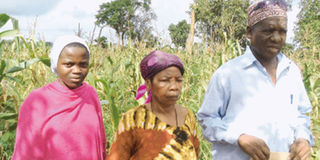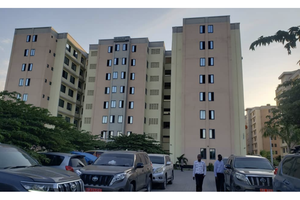We are happy to be back home!

Muya Omari Luhizo, 62, with his wife and daughter before they were granted Tanzanian citizenship by the minister for Home Affairs, Mr Mathias Chikawe, at Chogo in Handeni District, Tanga Region, yesterday. PHOTOS | LUCAS LIGANGA
What you need to know:
- The Somali Bantu (also called Jareer, Gosha or Mushunguli) are an ethnic minority group in Somalia who primarily reside in the southern part of the country, near the Juba and Shabelle rivers. They are descendants of people from various Bantu ethnic groups, most of whom were captured from southeast Africa and sold into slavery in Somalia and other areas in Northeast Africa and Asia as part of the 19th century Arab slave trade.
- Bantus are ethnically, physically, and culturally distinct from Somalis, and they have remained marginalized ever since their arrival in Somalia.
Muya Omari Luhizo, his wife Mesozi and daughter Fatuma, once classified as Somalis of Bantu origin, wore broad smiles after they were granted Tanzanian citizenship in Handeni District
Chogo, Handeni. The Luhizo family is all smiles these days. The old man, his wife and daughter are back home in Tanzania after years of living in war-torn Somalia. Sixty-two-year-old Muya Omari Luhizo, his wife Mesozi and daughter Fatuma, once classified as Somalis of Bantu origin, wore broad smiles last Friday shortly after they were granted Tanzanian citizenship at Chogo settlement, 12 kilometres off Dar es Salaam-Tanga road in Handeni District.
“Citizenship will open doors to opportunities available in this peaceful country, such as a job for my daughter,” he says, holding the citizenship certificate given to him by minister for Home Affairs, Mr Mathias Chikawe. “In the real sense, we are not Somalis. We are Wazigua since we are the products of Wazigua ancestors who were taken to Somalia as slaves.”
He always wanted to be a policeman, but his childhood dream was shattered by the fact that he had lived as a refugee since he fled to Tanzania from Mbolini in southern Somalia in 1992. “My family and I ran away from civil war, leaving behind my two sisters,” says the old man, now a maize farmer.
June 6, 2014 is a day that has left an indelible mark in 30-year-old Ramadhani Haji Eully’s family history. It is the day he was declared a bona fide citizen of Tanzania. “Only one life, Will soon be past; Only what’s done for Christ will last,” reads a T-shirt four-year-old Abdulrahman wears. He is one of Eully’s five children. Abdulrahman’s days of living as a refugee ended on Friday after he too received a citizenship certificate.
Mr Luhizo and Mr Eully were among 1,514 Somali Bantu refugees who were on Friday granted citizenship by the minister for Home Affairs, Mr Mathias Chikawe, at a colourful ceremony witnessed by the representative of the United Nations High Commissioner for Refugees (UNHCR) in Tanzania, Ms Joyce Mends-Cole. They had been considered refugees for two decades.
“Congratulations,” said Mr Chikawe as he handed out certificates to 19 families. “You’re now citizens of Tanzania.”
The newly-naturalised Tanzanians are free to vote and vie for political leadership. But Mr Chikawe had two requests in return: They must defend the country at all cost, given that the world today faces the threat of terrorism from all quarters, and they must abide by Tanzania’s laws.
Speaking on behalf of the new citizens, 50-year-old Omari Lugundi thanked the government for its generosity in granting them citizenship and land. He added: “We have waited for this day for a long time. People are shedding tears of joy today. Tanzania will never regret granting us citizenship. We will abide by the laws of the land to the letter. Give our regards to President Jakaya Kikwete.”
In December 2013, the government of Tanzania and UNHCR concluded a year-long process of registration, verification and naturalisation of Somali Bantu refugees residing in Chogo settlement in Handeni District, Tanga Region. It was their chance to apply for citizenship. The Ministry of Home Affairs approved some 1,514 applications.
“These are descendants of Wazigua (one of the major tribes in Tanga region),” said Ms Mends-Cole. “For us, they should not be refugees.”
She told journalists on Thursday that the Chogo settlement comes complete with a health centre, two primary schools, a secondary school, market, police post, community hall, water points and power distribution lines. All of this is the result of nearly three years of construction work at a 5,000-acre site set aside by the government of Tanzania in 1999 to integrate the Somali Bantus locally.
The international community invested an estimated $2million in the initial construction of the settlement. UNHCR’s partners
in Tanzania include the government of Tanzania, the United Nations, the United States, the European Commission for Humanitarian Aid, the United Kingdom, Japan and Switzerland. Others are Germany, Sweden, Australia, Canada, Ireland, Belgium, Norway and Finland.
According to UNHCR, slave traders took advantage of a prolonged drought in East Africa in the late 1830s to falsely offer coastal tribes labour opportunities in foreign lands. Many accepted the offer in the hope of staving off starvation, including members of the Wazigua tribe in northern Tanzania, only to be sold as slaves when they arrived at their destinations.
One of the places they were brought to was the Benadir coast of Somalia, where they were forced to work in plantations producing sorghum, maize and sesame seeds for export through the Indian Ocean. Escaping slaves later established thriving farmer settlements on the fertile land along the Jubba River in southern Somalia.
In the early 1990s, a civil war broke out in Somalia and Siad Barre’s regime was overthrown, pushing many Somalis--including Bantus--to flee the country. A group of about 3,000 refugees of Bantu origin made their way even further south, to Tanga, reversing the path their ancestors had taken. They were granted prima facie refugee status.
Upon their arrival, the government of Tanzania hosted the Somali refugees at Mkuyu camp, where they received assistance from UNHCR and its partners. Although Mkuyu was designated a settlement, it did not have the full potential to allow refugees to become self-sufficient.
In 2003, more than a decade later, these refugees were transferred to the newly-constructed settlement of Chogo, some 80 kilometres away, in a move towards naturalising those who wished to stay on in Tanzania. A small number of refugees settled in Bagamoyo District in Coast Region and grew rice.




